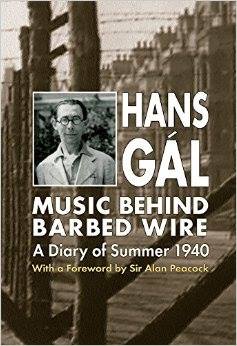Music Behind Barbed Wire
A Diary of the Summer of 1940 by Hans Gál
Music Behind Barbed Wire, written during internment captivity in 1940, is a vivid and very human account of personal survival and creativity in extraordinary circumstances. Gál’s fellow internees include a colourful array of distinguished personalities who emerge from the pages of the diary like characters in a tragi-comic human drama, both harrowing and humorous, immensely readable, and ultimately a monument to the human spirit and to the power of music and creativity. The book comes with a CD of music written during the internment. Translated by Anthony Fox and Eva Fox-Gál with Forewords by Professor Sir Alan Peacock and Richard Dove. Published by Toccata Press, 2014.
Review of Music behind Barbed Wire
by Ralph Blumenau (Amazon):
5.0 out of 5 stars A composer's diary while interned as an "enemy alien" on the Isle of Man in 1940,January 12, 2015 By Ralph Blumenau (London United Kingdom)
In May 1940, when Hitler launched the invasion of Holland, Belgium and France, the British government interned, as a precaution, many thousands of “enemy aliens” living in Britain. A very high proportion of these were in fact Jewish refugees from Nazi Germany. Among them was the composer Hans Gál. His group were first interned in a camp at Huyton, outside Liverpool, and were then moved to the Isle of Man. This book is the diary he kept during this time, and it makes absorbing reading. It has now been translated from the original German into English.
Gál was not only a musical but also a literary artist, and this diary is so vividly written that one feels one is sharing all his experiences. There is of course the indignation that these refugees should have been interned at all. The early days were particularly hard, with internees having to sleep on the floor, with insufficient food and inadequate sanitary arrangements; but even later Gál expresses sardonic and angry contempt at the insensitivity and incompetence of the military authorities, though he usually (with one exception) acquits them of malevolence: unlike the Nazis, they were after all not out deliberately to maltreat the internees. In fact the internees organized themselves much more efficiently than the authorities were able to do – the latter grateful, for example, at the card-index the internees provided: such an idea seemed never to have occurred to them, and as a result thousands of letters for the internees had piled up simply because the authorities were not sure in which of the houses a particular internee was accommodated. But self-organization went far beyond such administrative matters. Many of the internees were distinguished musicians and academics, and the camp very soon became a lively cultural centre, with lectures and concerts. In the latter Gál played a major part. While in Huyton, he composed a suite for two violins and flute (the only instruments at that time available in the camp), and later he wrote the music for a revue which was performed twice, the second time the day before his release. (The suite and the music for the review are recorded on a CD which comes with the book.) In the music we find the same wit that we find in the book: he records with amusement the comedies of a life which in general was not at all comic, especially for a man of his highly-strung and sensitive nature. He always finds the precise word: the physical conditions and the characters of his friends and of so many of the internees are brought brilliantly to life. Attractive also is his generous recognition and estimation of the qualities of others. The most moving pages are the last ones, which he penned on board the ship on which he returned to England and normal life: he reflects on the positive aspects of the experience, a sense of friendship, community and unselfishness which had developed in the camps, an awareness “that our life here had acquired a new and nobler meaning … and that we had been enriched by that and have enjoyed an atmosphere of comradeship and friendship such as we had never known before.”
Piano Quartet in AThis work, for piano (left hand), violin, viola and violoncello, was commissioned by, and written for, the one-armed pianist Paul Wittgenstein (1887-1961) in 1926, and first performed by Wittgenstein and the Sedlak Quartet in 1928 and subsequently on two further occasions. It was not published at the time. Gál later revised the work, probably after his emigration to Britain in 1938, but it still remained unpublished. It has now (2014) been reset, and published by Boosey & Hawkes/Benjamin under the Simrock label (EE 5419; ISMN 979-0-2211-2212-4.
Hans Gál: Ein Jahrhundert Musik. Eva Fox-Gál und Anthony FoxThis little book (in German) gives an outline of Gál's life and works with illustrations, and contains a list of all Gál's published works. It is edited by Gerold Gruber, director of the organisation exil-arte, and published in Berlin in 1912 by Hentrich and Hentrich in their series Jüdische Miniaturen. ISBN 978-3-942271-77-6.
Vier Miniaturen für Mandoline, Violine, Viola und Violoncello, op. 10a.
(Four Miniatures for mandolin, violin, viola and cello, op. 10a)
A new edition of this work has just been published by Joachim Trekel, Hamburg, who specialise in mandolin works. The work was written in 1914 for string quartet and published as opus 10. Gál produced this version for his friend the mandolinist Vinzenz Hladky in Vienna in 1937, with mandolin instead of 1st violin and lute instead of cello. Hladky published it in this form in 1967, but it has long been unavailable. This new edition reinstates the cello. It can be ordered with Trekel's catalogue number T6567. The original string quartet version is in print and available from Boosey and Hawkes under the title Five Intermezzi, op. 10.
New publications


